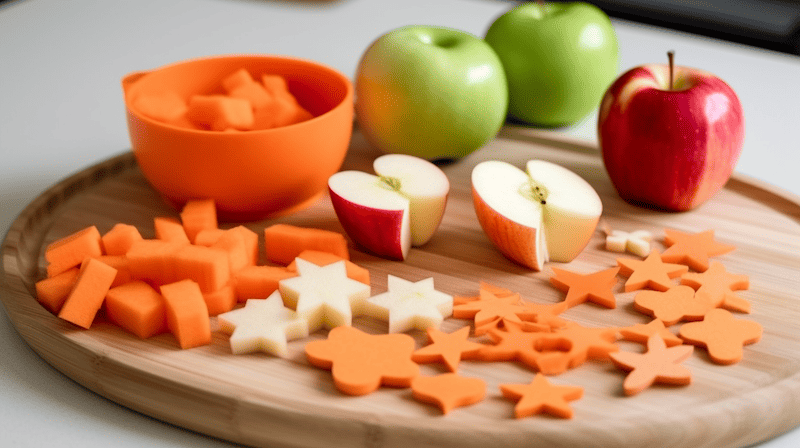Dealing with picky eaters can be one of the most challenging parts of parenthood. Unfortunately, it seems impossible for many parents to get their children to try new foods and develop healthy eating habits.
The good news is that there are simple ways to manage picky eaters in young kids without resorting to bribes or rewards. Instead, with a few easy tips and tricks, you can help your child become a more adventurous eater open to trying new things!
This article will explore practical strategies for managing picky eaters in young children. We’ll look at how to make mealtime enjoyable and provide guidance on introducing new foods into your child’s diet.
By the end of this article, you will have all the information necessary to ensure your little one develops proper nutrition and has an overall positive relationship with food.
Key Takeaway
Understanding Picky Eaters
It’s a common struggle for parents to deal with picky eating. Young children can be incredibly fussy when it comes to food, and trying to get them to build good eating habits and try something new or eat their veggies can become quite the battle!
Fussy eating is more than just not liking certain foods; it’s an issue of control kids often express by refusing certain meals.
Identifying these habits early on will help parents figure out how to manage their little picky eaters.

Identifying Fussy Eating Habits
Jack is 4 years old and has been a picky eater since he was young. His parents have tried to get him to eat the same meals as the rest of the family, but it’s an uphill battle every night.
Identifying fussy eating habits in children like Jack can help create healthy food habits that will last into adulthood:
- Pay attention to portion size – Children often become overwhelmed with large portions and refuse to finish their meals.
- Take note of new foods – If your child refuses anything unfamiliar on his plate, try introducing them slowly, one at a time, rather than all together.
- Experiment with flavours – Many children resist certain tastes or textures, so try incorporating just small amounts into existing favourites for some variety.
- Understand triggers – Observing when certain behaviours occur while preparing or serving food may explain why they resist trying something new.
Parents should remember that this process takes patience and understanding; getting kids to expand their palettes is not always easy, but consistency can make a huge difference in healthy eating habits over time!

Establishing Healthy Eating Habits
Once you have identified the eating habits of your picky eater, it’s time to start working on developing healthier ones. Meal prep is a great way to get the whole family involved in deciding which healthy foods will be served at dinner each night.
Ensure that everyone has input and that you represent all the food groups.
Planning for meals can also reduce stress around mealtime and make it more inviting for your child.
Involving your child in selecting, preparing, and serving meals will encourage them to try new things while creating an enjoyable environment at the dinner table.
Introducing New Foods To Your Child
Introducing new foods to your child can be a challenging endeavour. To make it easier, try presenting the food in an exciting way that draws their attention and encourages them to try it out.
A great example is cutting fruits into fun shapes or arranging vegetables on the plate appealingly. This helps break up the monotony and gives kids something new and exciting to explore!

When introducing new foods, remember that children’s taste preferences may evolve as they age. While picky eaters tend to cause power struggles at meal times, you should focus instead on getting creative with how you present food while maintaining healthy eating habits.
Doing so will help prevent both of you from becoming overwhelmed by the process! With patience and encouragement, you can slowly but surely introduce your child to all sorts of delicious meals without having a power struggle over mealtimes.
Avoiding Power Struggles At Meal Times
It can be very challenging to deal with picky eaters during meal times, and avoiding power struggles is important.
Staying calm and setting limits is key, but making eating an enjoyable experience for your children is also helpful. Offer them a variety of nutritious foods, including their favourites, while explaining why they should try new things and how good they will feel afterwards.
Additionally, don’t force them to clean their plates if they become full before finishing the food; instead, use positive reinforcement when taking a bite or something unfamiliar.
This way, you can create a pleasant atmosphere that encourages healthy habits without making mealtimes stressful for you or your kids. With patience and consistency, you can help your child develop healthier eating behaviours — now let’s look at ways we can make mealtimes fun and positive!
Making Mealtimes Fun And Positive
Making mealtimes fun and positive is essential to managing picky eaters in young children. With the right strategies, parents can create a more enjoyable and healthy mealtime environment for their family.
Here are some ways to make mealtimes more enjoyable:
- Try new recipes with your child by adding interesting ingredients such as olive oil or fruit – this will give them a sense of ownership over the meal and make it more likely that they’ll try it!
- Invite another family member to join you at the table – having someone else around may help encourage your picky eater to be adventurous with food.
- Make sure to focus on the positive experiences during meals rather than the negatives – praise your child’s attempts at trying something new.
- Offer healthy snacks throughout the day so they don’t fill up before dinner. This way, they’re less likely to reject what you serve at dinnertime.
In addition to these steps, creating appealing meals for picky eaters also plays an important role in helping manage their reluctance towards certain foods.

Preparing Appealing Meals For Picky Eaters
Managing picky eaters in young children is like running a race – it requires focus, determination and the ability to stay one step ahead.
Preparing meals that appeal to toddlers and their taste buds can be equally challenging. However, with some creativity and patience, parents can find ways to make nutritious foods enjoyable for even the pickiest of kids.
Incorporating healthy ingredients into favourite dishes or making fun shapes out of whole grain pieces of bread are some of the clever methods parents use when cooking tasty yet nourishing meals for the little ones. Even small changes, such as using creative names for unfamiliar food items, can help spark an interest in trying something new.
Ultimately, any effort put towards helping children adjust their eating habits will result in healthier lifestyles over time. With this in mind, we now focus on encouraging healthy eating habits in the whole family.
Encouraging Healthy Eating Habits In The Whole Family
Providing a healthy, balanced diet for young children can be difficult. When managing picky eaters in toddlers, it is important to develop an understanding of the family’s nutrition needs as a whole.
Encouraging healthy eating habits throughout the entire family will create a positive atmosphere at mealtime and set an excellent example for your toddler. In addition, incorporating nutritious ingredients into meals together, making meal preparation interactive, and ensuring all household members are present during mealtimes can help promote healthier choices.
In addition, setting reasonable expectations and avoiding pressure or incentives regarding food consumption may also encourage better nutrition habits in your little one. Finally, eating healthy should not be seen as something that has to be done out of obligation but rather something everyone can enjoy doing together as a family.
Understanding A Child’s Appetite
As the adage goes, ‘You are what you eat.’ So when it comes to young children who don’t have a large appetite or refuse to try new foods, understanding their cravings and appetites is key for parents.
| Child’s Appetite | Fussy Behaviour | Parent Response |
| Increase | Refuse food items | Offer encouragement & support |
| Decrease | Demand certain foods | Provide healthy alternatives in moderation |
| Unstable | Eat too much of one item | Balance portions with other nutritious options |
It can be difficult as a parent when your child is fussy – but if you take the time to understand their individual needs, it will help them establish lifelong eating habits that are both enjoyable and healthy.

Allowing them to explore different flavours while guiding them along the way can create an environment where they feel comfortable trying something new. It’s important to remember that every child has a unique palate and preferences; it’s best not to compare or force any particular food choice upon them.
By recognizing these differences, parents can work with their children to manage picky eaters. When meal times become stressful, making adjustments at home can help ease some of the tension. Establishing a routine by setting specific times for meals can also aid in developing better habits over time.
Creating an inviting atmosphere free from distractions such as TV or screens further encourages positive experiences around food consumption. With patience and consistency, the entire family can learn how to manage picky eaters effectively – allowing everyone involved to enjoy mealtimes more!
Making Meal Times Easier For The Entire Family
Making meal times easier for the entire family can be challenging when there are fussy or picky eaters in young children. Feeding these little ones can become a battle of will if they don’t like what you serve, but it doesn’t have to be that way!
If you create an atmosphere of fun and exploration around mealtimes, your child will be more likely to try new foods. Try serving meals with different colours and textures and adding lots of flavours; this will make them feel adventurous and excited about eating something unfamiliar.
Letting children help prepare their food also encourages them to take ownership of the meal and get involved in making healthy choices!
Mealtimes should not be stressful, so by creating a relaxed environment where everyone is respected, and you’ll foster positive attitudes during feeding time. It’s important to remember that all children go through stages of fussy eating – even the most adventurous eater might decide one day that they only want vegetables on their plate!
Don’t worry – this too shall pass.
Finding Healthy Food Options For Picky Eaters
It is widely believed that picky eaters are born, not made. However, studies have shown that children exposed to a wide range of healthy food options may be likelier to try new items and develop healthier eating habits.
Providing healthy alternatives can make meal times easier for the entire family when it comes to accommodating the needs of picky eaters in young children. For example, instead of only offering bread or processed meats as an option, parents could include both a sandwich and a salad on the menu, allowing kids to choose between two nutritious meals.
Additionally, having some snacks like apples or carrots readily available will give kids something to turn to when they’re hungry but feel free to attempt something outside their comfort zone.
Ultimately, by introducing these small changes into mealtimes at home, parents can help encourage their child’s independence while also teaching them about nutrition and ensuring they get all the necessary vitamins and minerals daily.

Supporting A Child’s Independence Through Eating
Parents of picky eaters sometimes feel overwhelmed when it comes to mealtime. As a result, it can be difficult for a child to trust their hunger and eat without being coerced by parents or siblings.
To help support a child’s independence, try to refrain from forcing them to finish what they have on their plate if they do not appear hungry anymore. Instead, allow them to cook with you in the kitchen, making them more likely to sample new foods and become comfortable around different ingredients.
Additionally, it allows children to practice important skills such as following instructions and measuring ingredients – all while having fun! Finally, introducing cooking into your household routine will enable children to determine what works best for their taste buds.
With patience and understanding from parents, these meals may eventually become something both parent and child enjoy cooking together – even picky eaters!
Tips For Avoiding Boredom With The Same Meal
It’s hard to imagine a picky eater not wanting to gobble down their fair share of chicken nuggets. After all, what child doesn’t love the taste of that golden-brown crunch? Unfortunately, however, it’s this repetitive option in school lunches – and at home! – which can turn kids off food altogether.
So how do we keep our little ones interested when they eat something familiar every day?
One way is to use examples as an invitation for exploration. Letting children take small bites of different foods (even if it’s just one or two!) allows them to experience new tastes without overwhelming themselves with too much unfamiliarity. It also allows them to practice making choices about what they eat, helping them become more independent in their eating habits.
With enough encouragement and patience, these mini moments will slowly add up and help build trust between you and your child and broaden their culinary horizons.
Sometimes, though, even the most enthusiastic eater needs some extra inspiration on their plate. That’s why providing interesting shapes and textures to food can be helpful: think spiral-cut vegetables or fruit salad “kebabs” instead of plain slices; muffins over toast; homemade pizza pockets rather than frozen store brands…the possibilities are endless!
Providing Interesting Shapes And Textures To Food

For parents of picky eaters, providing exciting shapes and textures to food can effectively get your child interested in trying new things. However, it’s important to remember that asserting independence is a natural part of a young child’s development, so don’t force them into anything they don’t want.
Here are some quick tips for adding variety:
- Cut healthy food options into fun-shaped pieces like stars or hearts as an after-school snack.
- Offer dips with meals, such as hummus or ranch dressing, making even the most mundane foods more exciting.
- Encourage kids to try new foods by showing them how you enjoy different dishes – kids learn from examples!
Be creative when spicing up meals; remember that they should still be nutritious, not just junk food disguised as something else. The key is to offer choices while limiting what’s acceptable at meal times.
Conclusion
It’s no secret that managing picky eaters in young children can be a tricky task. Juggling meal times, power struggles, and introducing new foods make any parent want to throw up their hands!
But fear not – with some creative thinking and patience, it’s possible to help your picky eater become more adventurous.
First of all, try making food fun by providing interesting shapes and textures – this will encourage your child to explore different flavours without feeling overwhelmed.
Secondly, don’t force them into trying something they’re uncomfortable with; instead, let them take the lead so they feel empowered.
Finally, when you create healthy eating habits early on, you’ll have less stress at mealtimes.
So parents everywhere: don’t give up hope! With these tips for managing picky eaters in young children, you can ensure your little one grows up happy and healthy – even if they aren’t particularly fond of green beans or broccoli!







